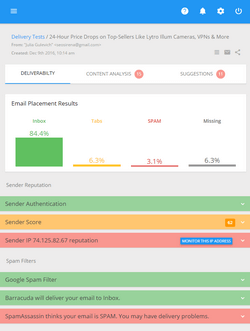6 Tips for Writing Better “Subject” Lines
Like the From field the Subject line is one of the most important components of a successful newsletter sending campaign. Together with the From line, the Subject line determines whether the recipient will open an email, delete it immediately, save file it for future reading, or report and/or filter it as spam. Plus, many anti-spam filters use the Subject lines to separate good emails from spam. So, because of a poorly written Subject the email may not even reach the recipient’s inbox in the first place.
Below are the tips to write Subject lines that produce higher open and click-through rates:
- Inform – the Subject line should say something important, urgent or valuable and make the recipients think that if they don’t open the email right now, they will miss something of value.
- Intrigue – as the Subject line is a major driver of click-through rates, it must intrigue the recipient and stimulate them to open the email immediately.
- Instill trust – a good practice is including the name of your company or product in the Subject line. The name is usually enclosed in brackets and put at the beginning: "[G-Lock Software]: New exclusive HTML templates are ready for download and use!" Branding the company or product name into the Subject line ensures the recipients that the email is coming from a trusted source.
- Be specific – make the Subject line as narrow as possible to excite the interest from a majority of recipients. Abstract Subject lines, such as "[G-Lock Software]: May 2008 Newsletter" may seem too boring and may not work for all readers. Writing specific Subject lines is important if you segment your list and send targeted email messages for each segment. Each segment should receive appropriate and different subject lines.
- Check Subject lines in your inbox – you can go to your inbox to read the Subjects of the messages. What Subject lines intrigue you and make you open the emails immediately? What Subjects seem trite and vapid? Another good idea is to dig into your spam folder if it contains any spam emails. At least, you’ll find out how common spam Subjects lines read and try to compose your Subject differently.
- Test different Subject lines – the simplest way to know what Subject line works better is to test. Split your email list in two, three, or even four groups and send the same message but with different Subject lines to each group. Then track the emails to understand what driver in the Subject line works better.
You know fear and opportunity are often the key drivers in email marketing. You can do split tests to discover which one works the best for your business. We did such a test. We sent an email message with the Subject 1
"[Fast Blog Finder] Learn about shady link building methods you should avoid!"
to a half of the mailing list and the same message with the Subject 2
"[Fast Blog Finder] Don’t you use shady link building methods that can hurt your website?"
to a second half of the list. The result was a copy with the Subject 2 (based on fear) generated about 16% open rate and a copy with the Subject 1 (based on opportunity) resulted in about 15% open rate. So, the conclusion is that fear can outperform other incentives and appeals. Don’t give up if the first test doesn’t show any outstanding results. Just keep testing consistently until you understand which type of the Subject line is the best driver for your recipients.
Table of contents | Page list for this chapter | Next page

